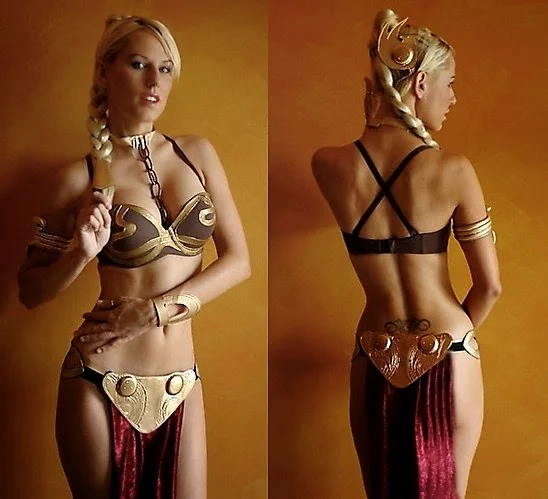In the Star Wars franchise, Princess Leia is known as one of the most iconic female characters. However, her character's sexualization in the third installment of the original trilogy, Return of the Jedi, has sparked controversy and criticism.
In Return of the Jedi, Princess Leia is captured by the vile gangster Jabba the Hutt and forced to serve as his slave girl. She is outfitted in a revealing gold bikini and chained up, serving as a decoration for Jabba's throne. This scene is infamous for its overt sexualization of Leia and has been the subject of much debate and criticism.
The gold bikini has become a cultural icon in its own right, with countless cosplayers and Halloween costumes featuring the outfit. It has also been referenced in popular media, such as the TV show Friends, where the character Rachel dressed up as "Slave Leia" for Ross's sexual fantasy.
Despite its iconic status, the sexualisation of Princess Leia in Return of the Jedi has been criticized for perpetuating harmful stereotypes and objectifying women. The scene reinforces the idea that women are meant to be objects of male desire, and it has been argued that it detracts from Leia's character development as a strong and independent leader.
Carrie Fisher, the actress who portrayed Princess Leia, has spoken publicly about her experiences filming the scene. In her memoir, The Princess Diarist, Fisher wrote about the discomfort she felt wearing the costume and performing the scene. She has described the outfit as "what supermodels will eventually wear in the seventh ring of hell."
Fisher has also been vocal about the pressures of being a sex symbol in Hollywood. She has spoken out about the double standards faced by women in the industry and the expectation that they should be both sexually attractive and talented. Fisher has been a champion for mental health awareness, and she has been open about her struggles with addiction and bipolar disorder.
While Princess Leia remains a beloved character in the Star Wars franchise, her sexualisation in Return of the Jedi continues to be a topic of discussion and criticism. The scene has sparked important conversations about the representation of women in media and the harmful effects of objectification.
It is worth noting that the infamous slave bikini outfit worn by Princess Leia in Return of the Jedi was not entirely original to the Star Wars franchise. The outfit was, in fact, inspired by a character named Dejah Thoris from the science fiction novel A Princess of Mars, written by Edgar Rice Burroughs in 1912.
Dejah Thoris is the Princess of Helium and a central character in the novel. She is described as wearing a revealing red silk outfit that leaves much of her body exposed. It is said that George Lucas, the creator of the Star Wars franchise, was a fan of the John Carter of Mars series and was inspired by Dejah Thoris' outfit when designing Princess Leia's slave bikini. The influence of science fiction on popular culture is undeniable, and the iconic slave bikini is just one example of how the genre has impacted mainstream media.
By donning the iconic gold bikini, fans are able to participate in a shared experience with others who appreciate the Star Wars franchise and its characters. Ultimately, dressing up as Slave Bikini Leia allows fans to express their love and admiration for the Star Wars franchise while also engaging in a fun and creative activity with others who share their passion.











